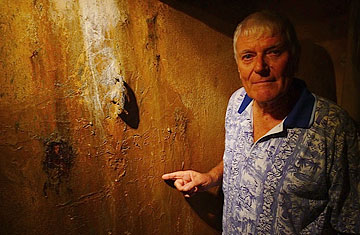
He was here Former Australian diplomat Bob Devereaux points to his 1975 inscription
Forty years after the last bombs fell on Vietnam's capital city, a chance discovery of a bomb shelter in the grounds of the Sofitel Legend Metropole Hanoi has prompted the hotel to create the Path of History tour, giving guests a taste of what life was like during the dark days of the Vietnam War.
The climax of the tour is a descent into a long-lost, recently unearthed wartime bunker in the hotel grounds. It was erected in the wake of operation Rolling Thunder in February 1965 as a refuge for guests and remained in operation until the U.S. concluded its Christmasbombing campaign in 1972.
Among the first to take the recently launched tour was 68-year-old Filipina journalist Gemma Cruz Araneta, who stayed at the hotel — then named the Thong Nhat or Reunification Hotel — for a month in 1968. In a diary entry dated 24 May, she describes being awakened in the early hours by the distant sound of antiaircraft guns and seeing flashes of light on the horizon, before the air raid siren resounded through the halls and someone hammered on her door.
"Most of the guests were already assembled in the lobby. Three American students staying at the hotel — they were known as 'draft dodgers' in those days — and a lady from New York went down first," she says. "There was some snickering among the rest of us about how they knew how deadly American bombs could be."
Forty-four years later, Araneta retraces her steps down into darkness of the 40-square-metre shelter. The green wooden chairs, electric lights and fan she remembers from her time in the shelter back in '68 have long gone, but otherwise the shelter looks pretty much as it did. "I thought 'wow, this could make a groovy discotheque,'" she recalls.
The original heavy metal doors that divided the five chambers still hang from their hinges. Water drips onto the dirt floor from air ventilation shafts. Old wiring curls out of rusted circuit breakers. Original light bulbs are still screwed into their sockets. And, at the back of one room, an inscription: BOB DEVEREAUX, 17 AUG 1975.
The tag had hotel staff scratching their heads, but Devereaux contacted the hotel after reading the story in an Australian newspaper to introduce himself and apologise for his handiwork.
"I can't remember doing the graffiti. They found a couple of empty bottles in the shelter, so it could have been while I was down there, looking for a bottle of wine," he confesses.
Devereaux was former second secretary of administration for the Australian embassy from 1975 to 1977 when it was housed within the hotel and used the shelter for extra storage when room 249, his living and working quarters, got too cramped.
"My memory of that air raid shelter is of a dark, gloomy dingy place, which was hard to find your way around. There was lots of water in the floor, and you could never be sure about snakes and rats... It has been suggested that I inscribed my name to find my way out!"
Now, of course, the shelter is much more welcoming.
Following several months of excavation, the water has been pumped out and kept at bay. A new staircase, flanked by contemporary images of the hotel, provides accessfrom by the pool and Bamboo Bar, and historian Andreas Augustin has trained six local volunteers to lead the guests-only daily tour.
General manager Kai Speth says that when the shelter's location was rediscovered, he felt a responsibility to refurbish and open it as a tribute to the hotel's dedicated war-era staff.
"Imagine what it would have been like for both the people working here and the guests," he says. "When you're in the shelter, you can still hear what's going on outside, wondering whether the structure would withstand it if a bomb hit. And many guests were Americans, the enemy at the time," Speth says. "I really think the bunker will become a destination in its own right."
